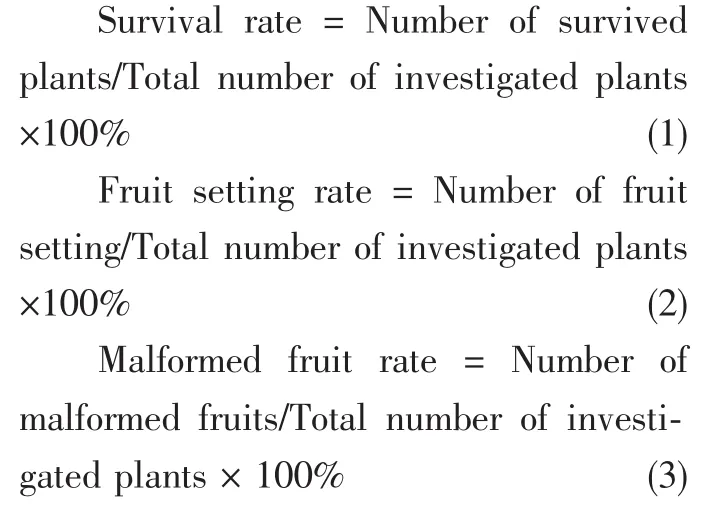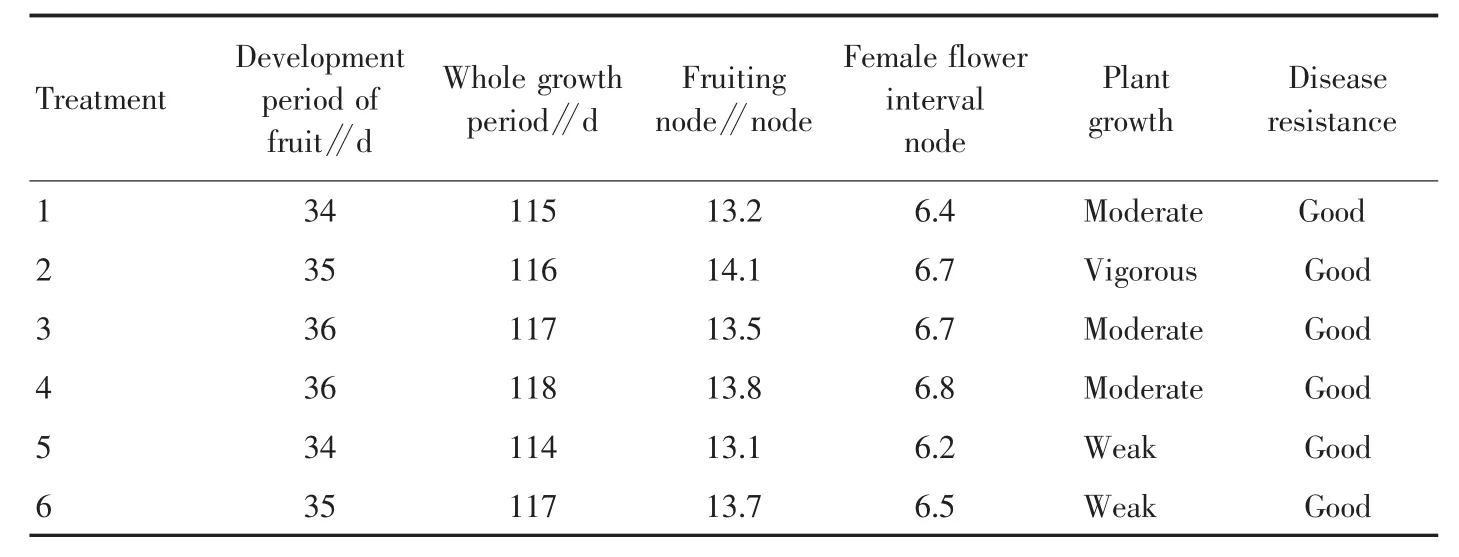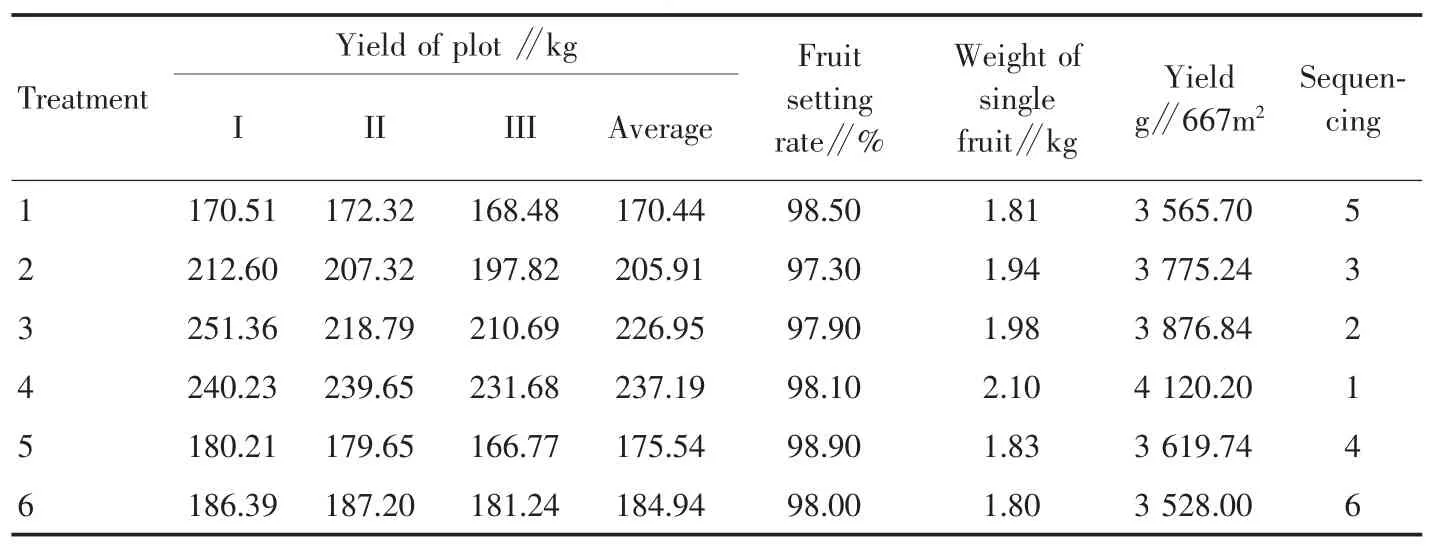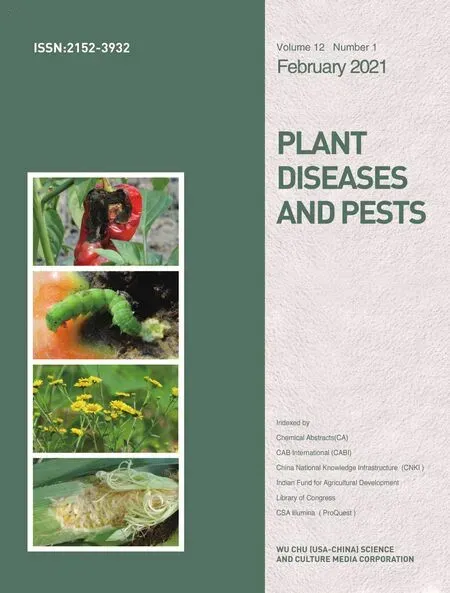Effects of Different Amino Acid Fertilizers on Growth,Development and Quality of Mini Watermelon under Substrate Cultivation
2021-02-26ZengJianboMaChaoZhangYingLiTingHuXiaoyiYouXuesongChenYanli
Zeng Jianbo,Ma Chao,Zhang Ying,Li Ting,Hu Xiaoyi,You Xuesong,Chen Yanli
Beijing Agricultural Technology Extension Station,Beijing 10029,China
Abstract In order to select suitable mini watermelon varieties for spring greenhouse cultivation under substrate cultivation,the field character,yield character,quality character and trade trait of six new mini watermelon varieties with red flesh were compared in the test.The results showed that mini watermelon applied with alanine and arginine had obvious advantages in quality character,yield character and trade trait.The yields reached 3 876.8 and 44 120.20 kg/667m2;the weight of single melon reached 1.98 and 2.10 kg;and the central sugar content reached 13.34% and 13.25%,respectively.Meantime,mini watermelon was juicy,sweet,tasty and refreshing,and was suitable for planting under substrate cultivation.
Keywords Substrate cultivation;Mini watermelon;Amino acid fertilizer;Growth and development;Quality
As a traditional advantageous crop in Beijing,watermelon is featured by obvious industrial advantages.In recent years,with the adjustment and upgrading of agricultural structure in Beijing,higher requirements have been put forward for standardized and balanced production,branded and differentiated operation,ecological and efficient demand of watermelon industry,which also points out the direction for industrial upgrading and development.
Conventional facility watermelon planting in Beijing is dominated by soil cultivation,and has some shortcomings such as low utilization rate of land resources and water and fertilizer,high labor intensity,serious soil-borne diseases such as Fusarium wilt and nematodes.In addition,watermelon cultivation is mainly based on experience,with low standardization and modernization.
Substrate cultivation has gradually developed in vegetable protected cultivation in China[1].Substrate cultivation effectively overcome soil-borne diseases and continuous cropping obstacles,reduce pesticide consumption,save water and labor,improve yield per unit area,and even achieve annual planting in facilities that are not suitable for cultivation or crop rotation,which has obvious comparative advantages compared with soil cultivation[2].Therefore,the technology is an effective method to solve continuous cropping of facility watermelon.Due to fixed formula of nutrient solution and automatic irrigation of water and fertilizer,large-scale and standardized production can be realized,and the product quality is stable,which is conducive to green,safe and efficient development of watermelon industry[3-7].Therefore,it can not only make full use of external conditions such as light,temperature,water,gas and fertilizer,but also increase the yield and improve the quality of plants by choosing appropriate functional fertilizer under substrate cultivation.At present,screening of amino acid fertilizers for facility watermelon in China is mainly carried out under soil cultivation,and there are few studies on substrate cultivation.
The effects of five different amino acid fertilizers on field character,yield character,quality character and trade trait of six new mini watermelon varieties were compared,in order to screen appropriate amino acid fertilizers and provide the theoretical basis for large-scale substrate cultivation production.
1 Materials and Methods
1.1 Materials and experimental sites The main amino acid fertilizers were lysine,tyrosine,alanine,arginine,histidine and CK.CK referred to the control without applying any amino acid fertilizer.Treatments 1-5 were applied with lysine,tyrosine,alanine,arginine and histidine at the dose of 2.5 g/L during vein elongation stage,fruit setting stage,fruit expansion stage and maturity stage.All amino acids were applied four times during the whole growth period.Other management measures were consistent with that in control.Treatment 6 was the control.
1.2 Experimental design The cultivation pattern was double rows per ridge and hanging vine cultivation,and plants were pruned according to the principle of“one plant on each side,main vein bearing melon”.The plant spacing was 35 cm,and the density was 30 000 plant/hm2.Each treatment replicated three times,with a total of 18 plots.Each plot covered an area of 37 m2,and 110 plants were planted.In addition to varieties,field management measures of each treatment were consistent,and water was slightly sprayed.
1.3 Methods
1.3.1 Specification of greenhouses The greenhouses were 10 m wide from east to west and 58 m long from north to south.Drip-free PO film produced by formal manufacturer was selected as greenhouse film,and both sides of greenhouse film could be ventilated.Seedlings were raised by nutrition bowl,nutrition disk and substrate nutrition soil.Grafting technology was adopted,and the stock was Jingxinzhen No.4.
1.3.2 Cultivation pattern.Black cultivation tank with the specification of 25-30-25 cm was used.A layer of thickened insect-proof net was laid in the groove during cultivation,and substrate was placed on insect-proof net.
1.3.3 Selection of substrate.The formula of cultivation substrate was peat∶perlite∶vermiculite=7∶3∶4 (W/W).The substrates were mixed,and added with 33 kg/m2chicken manure [organic matter content≥20%;pH 5.5-6.5;total nitrogen(N)≥0.8%;total phosphorus(P2O5)≥0.3%;total potassium(K2O)≥0.4%].The wellprepared substrate was disinfected with 50% carbendazim WP 800 times dilution,and filled in cultivation tank.
1.3.4 Water and fertilizer system.Each cultivation tank was paved with two drip irrigation tapes (diameter 15 mm,water outlet interval 30 cm).Precise fertilization system was applied,making outlet water of each drip irrigation tape uniform.Besides,filtration device should be installed to prevent outlet blockage.
1.3.5 Control of pH and EC values.The EC value during the whole growth period was controlled at 1.5-2.5 ms/cm,which was 1.5-1.8 ms/cm at seedling stage,1.8-2.0 ms/cm at vine elongation stage,and 2.0-2.5 ms/cm at fruit setting stage.
The pH value during the whole growth period was controlled at 5.5-6.0,which was 5.5-5.8 at seedling stage,5.8-6.0 at vine elongation stage,and 5.8-6.0 at fruit setting stage.
1.3.6 Control of pests and diseases.Powdery mildew and red spider were controlled by difenoconazole,chlorothalonil and triadimefon during vine elongation stage and fruit setting stage;aphids were controlled by imidacloprid,and bollworm and oriental tobacco budworm were controlled by Kongfu AS.The experimental plots were planted on March 15,pollinated on April 16,and harvested on May 25.
1.4 Survey indicators and measurement methods
1.4.1 Survey time.Growth period was surveyed from January to May;field characters were surveyed from March to May;yield and quality characters were surveyed in May;and disease resistance was surveyed from January to May.The disease resistance of various varieties against anthracnose,Fusarium wilt,gummy stem blight and viral disease were measured by naked eyes during seedling stage,fruit setting stage and maturity stage,respectively.
1.4.2 Formula.

1.4.3 Measurement methods.Mature fruits of five plants were randomly selected from each plot at maturity stage,and average weight of single fruit was calculated.During maturity stage,10 representative fruits were selected from each plot to measure flesh thickness,fruit shape index and soluble solid content,and the average value was calculated.The taste of fruits was recorded.Each plot was harvested individually,and the actual yield was recorded.
1.5 Data processing Variance analysis of data were performed by SAS software,and significance test was done by Duncan’s new complex range method(P<0.05).
2 Results and Analysis
2.1 Major field characters As shown in Table 1,the fruit development periods of various treatments were 34-36 d under consistent field management measures.The fruit development period of treatment 1 and treatment 5 was the shortest of 34 d;followed by CK and treatment 2,which was 35 d;the fruit development period of treatment 3 and treatment 4 was the longest of 36 d.The whole growth period of each treatment was consistent with the trend of fruit development.The fruiting node of various varieties ranged from 13.1 to 14.1;the fruit setting of treatment 5 was the best,and the fruiting node was 13.1;the highest fruiting node of treatment 2 was 14.1.The female flower intervals of various varieties ranged from 6.2 to 6.8;the female flower interval in treatment 5 was the smallest of 6.2,and that of treatment 4 was the greatest of 6.8;the female flower intervals of other four treatments were 6.4-6.7;and there was no significant difference among treatments.The plant growth of treatments was inconsistent,among which plants in CK and treatment 5 grew weakly,while those in treatment 2 grew vigorously,and plants in resting three treatments grew moderately.

Table 1 Effects of different amino acids on main field economic characters of mini watermelon
2.2 Yield characters
2.2.1 Yield.As shown in Table 2,the yield of the plot applied with arginine was the highest of 237.19 kg,significantly higher than those of other treatments.The yield of the plot applied with lysine was the lowest of 170.44 kg.The yields of other plots were 175.54-226.95 kg.The variation trend of yield per 667 m2was consistent with plot yield.The yield applied with arginine was the highest of 120.20 kg,followed by that applied with alanine(3 876.84 kg),and the yields of other treatments were 3 565.70-3 876.84 kg.The yields per 667 m2applied with histidine and lysine were the lowest of only 3 159.628 and 3 030.89 kg,significantly lower than those of other treatments,but all yields were higher than that in CK.

Table 2 Effects of different amino acids on yield characters of mini watermelon
2.2.2 Weight of single fruit.As shown in Table 2,the average weight of single fruit in different treatments successively were arginine (2.10 kg)> alanine (1.98 kg)>tyrosine(1.94 kg)>histidine(1.83 kg)>lysine(1.81 kg)>CK(1.80 kg).The weight of single fruit applied with arginine was 2.10 kg,while those of CK and treatment 1 (lysine)was low,with poor yielding ability.The fruit setting rate of various varieties ranged from 97.3%to 98.9%;the fruit setting rate applied with histidine was the highest of 98.9%,while those applied with tyrosine was the lowest of 97.3%.There was no significant difference in fruit setting rate among varieties.
2.3 Comparison of fruit trade traits As shown in Table 3,fruits were elliptic,green with dark green serrate stripes,and dark green pericarp.The fruit shape indexes were 1.04-1.50,and the fruit shape indexes of treatment 3 and 4 were higher of 1.44 and 1.43,respectively;the fruit shape index of CK was the lowest of 1.33.Through comprehensive comparison of fruit traits,fruits in treatment 3 had fresh green pericarp,clear and neat stripes,strong pink flesh and good commodity,and the pericarp hardness also reached 13.10 kg/cm2.

Table 3 Effects of different amino acids on trade traits of mini watermelon
2.4 Comparison of fruit quality As shown in Table 4,the central soluble solid content in treatment 3 was the highest of 13.34%;followed by treatment 4,with central soluble solid content of 13.25%;the central soluble solid content in treatment 1 and treatment 5 were also greater than 13%;and the central soluble solid content in CK was the lowest of 12.90%.Meantime,the minimum difference between marginal and central soluble solid was 2.4%,while the largest was 2.7% in treatment 2.Treatment 3 and treatment 4 had better flesh and taste.The pericarp thickness of six varieties was 0.44-0.57 cm,and the pericarp of treatment 5 was the thinnest of 0.44 cm.

Table 4 Effects of different amino acids on quality characters of mini watermelon
3 Conclusion and Discussion
Conventional facility watermelon planting in Beijing is dominated by soil cultivation,which has some shortcomings such as low utilization rate of land resources and water and fertilizer,high labor intensity,serious soil-borne diseases such as wilt disease and nematode.Substrate cultivation is an effective method to solve the problem of continuous cropping of facility watermelon.Amino acid fertilizers were screened under substrate cultivation.The results showed that mini watermelon applied with alanine and arginine had obvious advantages in quality character,yield character and trade traits.The yields reached 3 876.8 and 44 120.20 kg/667m2;the weight of single melon reached 1.98 and 2.10 kg;and the central sugar content reached 13.34% and 13.25%,respectively.Meantime,watermelon was juicy,sweet,tasty and refreshing,and was suitable for planting under substrate cultivation.
杂志排行
植物病虫害研究(英文版)的其它文章
- Integrated Prevention and Control Techniques of Infectious Diseases of Vegetables
- Disease-resistant Mechanism of Pepper against Root-Knot Nematode(Me1oidogyne spp.)
- Research on Chemical Prevention and Control against Stem Base Rot of Sweet Potato
- Inhibitory Effects of Sixteen Fungicides on Mycelial Growth and Spore Germination of Monilinia fructicola
- Crystal Structure of Poly[(2,6-di(2’,4’-dicarboxylphenyl)pyridine-κ4 O:O′:O″:O′′′)-(μ2-1,4-bis(1-imidazolyl)benzene-κ2N:N’)cobalt(II)],C39H24Co2N7O8
- Morphological and Biological Characteristics of Rhynchaenus empopulifolis in Tai’an,China
